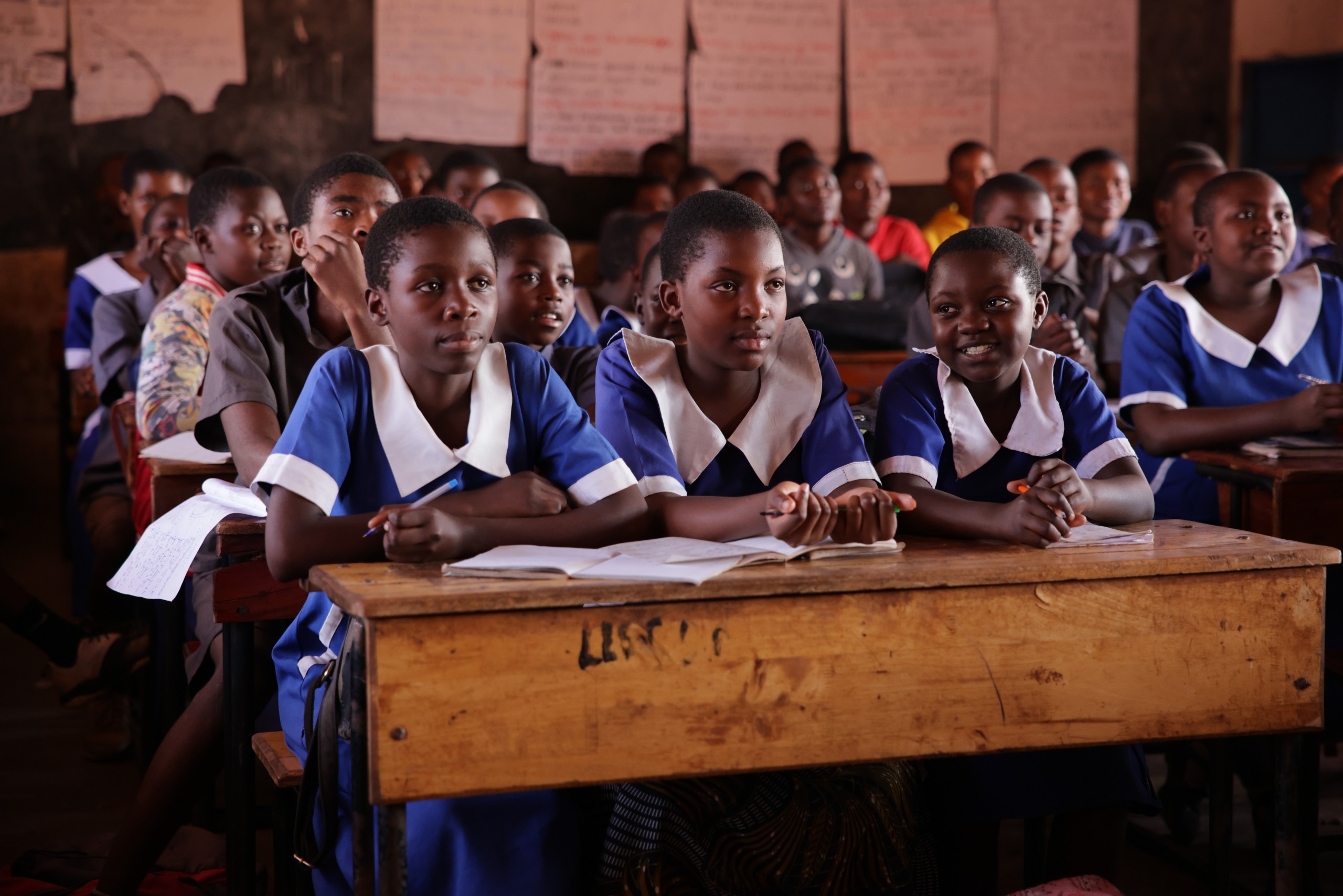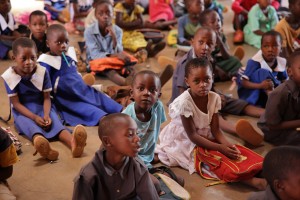
Driving down the dusty red dirt roads of Malawi’s capital city of Lilongwe, our truck flew past groups of children in bright blue dresses and grey uniforms, some as young as five years old. Some wore shoes or socks on their feet, a handful had small backpacks slung over their shoulders, and others without uniforms walked alongside.
Passing by small brick homes and dry farmlands, over 5,000 of these children walk the roads of Lilongwe each morning from over 13 villages as far as 5 miles away – laughing and skipping along as any child would when socializing with friends. Their destination: St. John’s Catholic Primary School.
Founded in 1963, St. John’s Primary School and its staff of 69 teachers provide the invaluable gift of education to the children of these villages near Lilongwe. Funded by the efforts of the Missionary Childhood Association, St. John’s sits on a large plot of land with ten to twelve brick classroom buildings surrounding swaths of open space for playing and trees for studying under. To accommodate the considerable number of ‘learners,’ the school holds classes in morning and afternoon sessions. At all hours of the day, children are seen and heard playing, studying in groups, and reciting lessons with their teachers from inside the simple classroom buildings. With eyes closed, St. John’s would sound like any other Catholic school in the world.
But our eyes were opened to the astonishing feat St. John’s faculty pulls off in educating so many students with so little space and resources. Walking amongst hundreds of children and speaking with Mary, the headmistress, the lack of simple necessities such as shoes, books, writing materials, and desks was deeply apparent. Yet despite this harsh reality, each learner approached me eager to share a smile, a high-five, a hug, or an answer about which subject was their favorite in school. The joy of learning was infectious – as an elementary-school girl I never would have said English was my favorite subject as enthusiastically as a little boy did when he giggled at me!
A hot wind blows through the brick open-air awnings attached to the outsides of classroom buildings. Up to 50 students sit in these makeshift classrooms, watching and reciting vocabulary as their teacher writes on a chalkboard on the exterior brick wall of the building with only one or two notebooks and pencils visible among the learners. These spaces are reserved for the children in third through sixth grade.
For the youngest students at St. John’s, as many as 60 students sit in groups on the floors of covered classroom buildings – walls littered with colorful crayon diagrams of animals, colors, vocabulary terms, class schedules, and rules of etiquette. One large sheet outlines the rules of the classroom, the words “We must be punctual,” “We must respect each other,” and “Boys must tuck in uniform” written in the easily identified manuscript of a young student.
Desks, a precious commodity, are reserved for the indoor classrooms of the seventh and eighth grades as boys and girls prepare to take their secondary school entrance exams. While 2,000 students from the surrounding area may apply to attend secondary school each year, only 200 are welcomed at the nearby institution. With the odds stacked against them, St. John’s prides itself on having a high acceptance rate from their 8th grade class. What little resources are available at the school are saved for higher grades, so they are adequately prepared for their future education or careers.
One among the fourteen-year-old learners is Lawrence, the school’s Head Boy. In a clean-pressed dark gray uniform, Lawrence exuded gratitude and sincerity when he addressed our delegation from TPMS-USA. As Lawrence expressed his thanks for the cooperation of TPMS and the Malawi Government to fund St. John’s School, he voiced the concerns of the students where further support could be given. “The most crucial thing is the maintenance of the classrooms,” he said, “during the rainy season they leak and have some cracks. We are always scared of these during our classroom sessions.” It was easy to find large cracks that ran from foundation to roof in the simple brick structures that housed the learning sessions.
While talking with Lawrence and the Head Girl, Florence, we learned that the students at St. John’s are introduced to MCA at a very young age, stressing the importance of their missionary call through their baptism and the necessity for prayer and sacrifice as a means of helping other schools around the world the same way their school was supported by the Missionary Childhood Association 60 years ago. Even though less than 20% of the students are Catholic, even the smallest children recognize the work of TPMS in their school and their duty to pay it forward.
The juxtaposition of incredible need and a sense of obligation to help less fortunate students around the world was startling – and it made me wonder if middle-school students in American Catholic Schools ever stop to consider the same duty Lawrence expressed to us. The profound joy and hope permeating the campus of St. John’s was contrasted by the stories of the students, teachers, and administrators making do with the little resources and cramped office space they had. While the American Church is forced to close Catholic Schools due to low enrollment, the Church in Malawi can hardly open schools fast enough to accommodate the students in search of a brighter future.
Walking through the classroom buildings and out onto the dusty red field, I was reminded of Aristotle’s words: “Educating the mind without educating the heart is no education at all.” The mission of the teachers at St. John’s is not only to give their students an opportunity to flourish and excel in their future careers but to instill a deep sense of gratitude and care for the common good in their hearts. Where hope and joy abound in the classrooms of St. John’s Primary School, respect and generosity grow within the next generation of the Church in Malawi.


